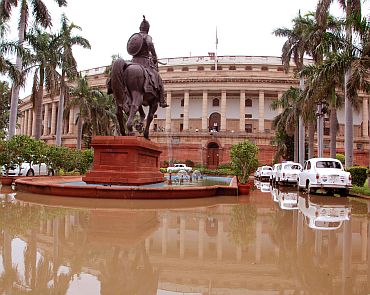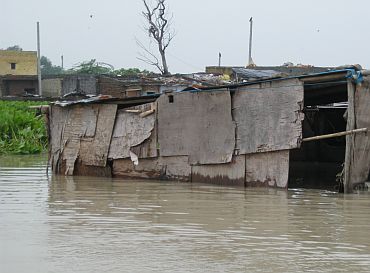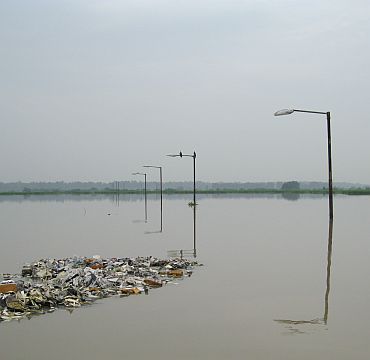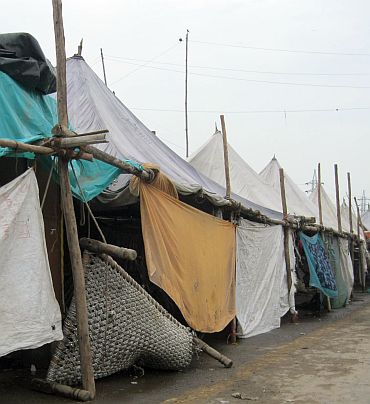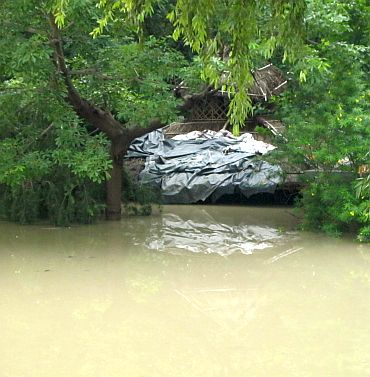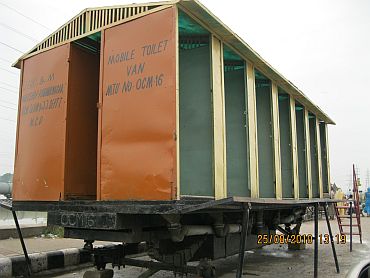 | « Back to article | Print this article |
Yamuna, Delhi's own river of sorrow
Sahim Salim travels to villages flooded by an overflowing Yamuna and assesses the damage that it has caused
Delhi is sinking. Villages, ashram, paddy fields and schools have gone under the capital's own river of sorrow.
People living in villages on Yamuna's banks are using boats to reach their villages on what used to be tarred roads with street lights.
The Yamuna swell is fast breaching city boundaries, with water seeping over ghats near Delhi's main bus stand -- the ISBT.
Residents living in various villages along riverbanks near Shastri Park bridge in North Delhi have been evacuated. The five-kilometre long Shastri Park bridge is lined with makeshift tents along both sides.
Click on NEXT to witness the trail of destruction...
'I am concerned more about my buffaloes'
People wait expectantly on the newly defined riverbanks as their relatives, buffaloes, cows and crops arrive in boatloads.
Sixty-seven-year-old Himmat Singh of Asmanpur village in Kartar Nagar directs traffic along the banks.
He looks at his buffaloes, who are lying in the water oblivious to their owners' plights.
"I am concerned more about these poor buffaloes. They can't complain like we do. They just trust us blindly. We have to feed them, but their feed is under water back in the village," Singh says.
Water and toilets, yes. Food, no!
Its 500-odd residents have been rescued and brought to the Shastri Park bridge, where they are accommodated in tents.
For water, tankers belonging to Jal Board roam around and for toilets, the government has erected mobile-toilets along the road containing five 2"/2" toilets.
For food, well, they have to make that arrangement themselves.
'Our money and crops are in our houses'
"Our money is in our houses. Our crops are in there and so are our vessels. How do we cook food? Where should we get money from?" another resident Mukhtaar Singh says.
A boatman, Jagbir Singh has his hands full. On a trip to the village, this reporter joined him in his boat along with the villagers. At the village, people got onto what used to be their second-floor balconies to try and get back whatever belongings possible.
They fetch their cows and buffaloes, who have instinctively settled on higher lands.
Villagers fill the boat to the brim with sacks of wheat, kitchen utensils, some clothes, their cattle and themselves. Half submerged streetlights, which are erected on roads that is atleast 15 feet below the boat, are visible along the path the boat takes.
Vegetable seller turns boatman
Boatman Jagbir Singh is in high demand.
"I normally sell vegetables near the boat-club and this boat is a family legacy. I come from a long line of fishermen. In emergencies like these, I get the boat out and give help to whoever seeks it. This is my second over-flooded village today. Earlier, I was in Wazirabad helping villagers fetch their belongings," Jagbir says.
Asmanpur, which was set up some 45 years ago sees floods every year, Himmat Singh says.
"Each year it is the same. There is nothing we can do about it. This year, however, the flood is really getting out of hand. Normally when Yamuna-ji swells, we get time to remove our crops. This time, she (Yamuna) was so angry, we barely had time to save our lives," Singh says.
Another village, same story
A kilometre ahead, there is another village on the same stretch with the same story.
This village of Gurjars (nomads) called Garhi Mendo also houses slum dwellers housed by the Delhi government. Now they are back in tents along the Shastri Park bridge.
"The Delhi government had rehabilitated us in Garhi Mendo with pakka houses. Here we are again though," says one ex-slum-dweller from the village, Babu Lal, pointing to his temporary abode.
Yamuna-ji, as the river is called fondly in Delhi, has not spared men of God either.
Yamuna has not spared men of God either
An ashram (hermitage) on the Wazirabad has gone under completely. The 13 Naga babas, who stay in the ashram, are on the roads in tents, combing their long hair and beards.
Naga Baba Gopal Bharti, a resident in the ashram says that the structure had been set up some 10 years ago.
"We have our own fields and some seven cows in the ashram campus. We had taken loan from the Delhi government to buy some seeds for growing medicines we sell. All that has been destroyed in the flood. We had a car gifted to us from one of the devotees. That car is now under water. Our laboratory, where we develop medicines have been destroyed completely," Bharti says.
Cricket academy under water
Walking on huge water pipes, the Baba points to an area in the river, which resembles a small abandoned forest.
A closer look reveals almost fully submerged gates of the ashram and its building. One can see the top of an Esteem car just outside these gates.
About half a kilometre ahead, Naseem Khan has thrown a fishing line into what used to be a cricket ground.
The ground is now filled with water and you can see a hoarding outside a half-submerged building declare 'Rajvanshi Cricket Academy'.
Khan is hopeful that he will be able to catch some fish from the cricket ground.
Old Railway bridge over Yamuna is shut
The Yamuna river has been rising steadily and is flowing above the danger level for the sixth consecutive day. As the river continued to swell menacingly, authorities have been forced to shut the old railway bridge that connects east district to rest of the capital.
On Wednesday, a water level touched 205.92 metres and is expected to reach 206.14 metres later in the evening, an official with the Irrigation and Flood Control department said.
The river had crossed the danger level of 204.8 metres on Friday.
The closure of the bridge resulted in the diversion of traffic onto a highway linking Delhi with Uttar Pradesh, which resulted in further choking of roads.
MCD closes drains to save city
The flood has affected areas in east, northeast and north Delhi, which is now over the "high density flood" mark.
Makeshift shelters have been erected on higher grounds in areas like Wazirpur, Shastri Nagar, Badarpur Khadar, Usmanpur, ISBT, Akshardham Temple area, Shakarpur and Okhla to shelter villagers affected by the flood.
Delhi government has closed the sluice gates of 17 nullahs falling in Yamuna to prevent rising water from coming into the city but civic authorities have assured that this will not lead to overflowing of drains.
Working overtime to pump out water
Commissioner K S Mehra assured that the closing of gates was a routine exercise undertaken by the Flood Control Department of the government to ensure that water from Yamuna does not flow into the city and cause a deluge.
"However, at all the 17 points, pumps have been installed and excess water from the drains are being pumped into the river itself. So there is no fear of overflowing of drains within the city. At eight points, 10 pumps each of MCD are working while at nine other points, pumps of Flood Control Department and DJB are at work," Mehra said.
